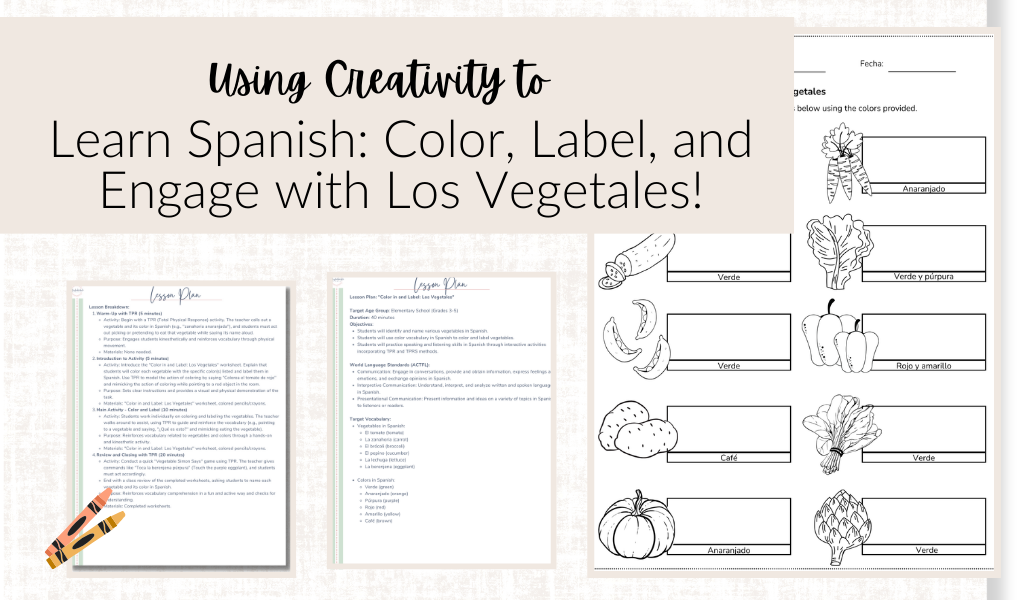Hey there, Joyful Journey Makers! 
Why Drawing Activates Learning
It’s not just about making things look pretty (although that’s definitely a bonus!). Drawing activates multiple areas of the brain, including the visual, motor, and language centers, making it an ideal tool for learning a new language. When students use their hands to color and label, they’re engaging their kinesthetic learning style, which can improve memory retention and understanding (Sousa, 2016). Plus, it’s calming—who doesn’t love a little quiet time to color? This calm atmosphere is perfect for language acquisition because it creates a low-stress learning environment where students can focus without feeling rushed or pressured.
The Science of Combining Drawing and Language Learning
There’s solid neuroscience behind why hands-on activities like coloring are effective for language learning:
5 Tips for Making Drawing & Speaking Activities Successful
- Set Clear Expectations: Let students know that they’ll be practicing both coloring and speaking Spanish. For example, as they color each vegetable, encourage them to say the name aloud in Spanish (e.g., tomate rojo).
- Incorporate Speaking Practice: Have students pair up after they’ve finished coloring. Each student can describe their worksheet to their partner by saying sentences like “Mi zanahoria es anaranjada” (My carrot is orange).
- Review in Small Groups: Break students into groups and have them quiz each other. One student points to a colored vegetable and the others say the color and name in Spanish.
- Use Movement: Turn the activity into a game! For example, play Simon Dice (Simon Says) where you give commands like “Toca el brócoli verde” (Touch the green broccoli), and students respond by pointing to or touching the correct part of their worksheet.
- Celebrate Creativity: Encourage students to get creative with their coloring. This might seem like a small thing, but by letting them choose unique color combinations for some veggies, you make the learning process more personal and memorable.
Common Classroom Management Challenges (and How to Avoid Them)
- Distractions During Quiet Time: Coloring can sometimes lead to students zoning out or talking off-topic. Set clear expectations that this is a time for quiet, focused work, and reward students for staying on task.
- Students Rushing Through: Some kids will rush to finish their coloring to be the first done. Make it clear that the quality of their work is important, and they should focus on making their colors and labels neat and accurate.
- Off-Task Discussions: While partner or group discussions are great for reinforcing vocabulary, make sure students stay on topic by circulating around the room and listening in.
Get Your Resource:
The “Color and Label: Los Vegetales” Activity
Let’s talk about what’s included in this veggie-packed packet! This fun, no-prep worksheet gives students the chance to color, label, and speak about vegetables in Spanish, reinforcing both vocabulary and colors.
Here’s what’s inside:
- Vegetable Vocabulary: Words like el tomate, la zanahoria, el brócoli, la lechuga, and more!
- Color Vocabulary: Students will practice using colors in Spanish, like verde, anaranjado, rojo, and amarillo.
- Engaging Lesson Plan: This resource also comes with a ready-to-go lesson plan (perfect for grades 3-5), complete with a TPR warm-up and a fun game to close the activity.
3 Fun Ways to Use this Activity in the Classroom
- Color & Speak: After students have colored and labeled their worksheets, pair them up for speaking practice. One student describes their vegetables, and their partner has to guess which vegetable they’re talking about based on the description.
- Classroom Display: Have students display their completed worksheets around the classroom to create a “vegetable garden” wall. Every time they pass by the wall, encourage them to say the names of the veggies in Spanish!
- Fast-Paced Review: Play a quick review game where you call out colors and vegetables (e.g., pepino verde), and students race to touch or point to the correct veggie on their worksheet.
The Gist of it All
Using creative, hands-on activities like Color and Label: Los Vegetales is a powerful way to reinforce Spanish vocabulary. By combining drawing, labeling, and speaking, we’re activating different parts of the brain, keeping students engaged, and making learning fun. Whether you’re turning this activity into a partner game or creating a colorful classroom display, this activity provides an easy, effective way to boost language retention while having a blast.
Want to make a whole unit out of it? Check out these additional resources now available on the Joyful Journeys in Language Learning TPT store!

Resources
Sousa, D. A. (2016). How the brain learns (5th ed.). Corwin Press.
Pashler, H., McDaniel, M., Rohrer, D., & Bjork, R. (2008). Learning styles: Concepts and evidence. Psychological Science in the Public Interest, 9(3), 105–119.
Gardner, H. (1983). Frames of Mind: The Theory of Multiple Intelligences. Basic Books


